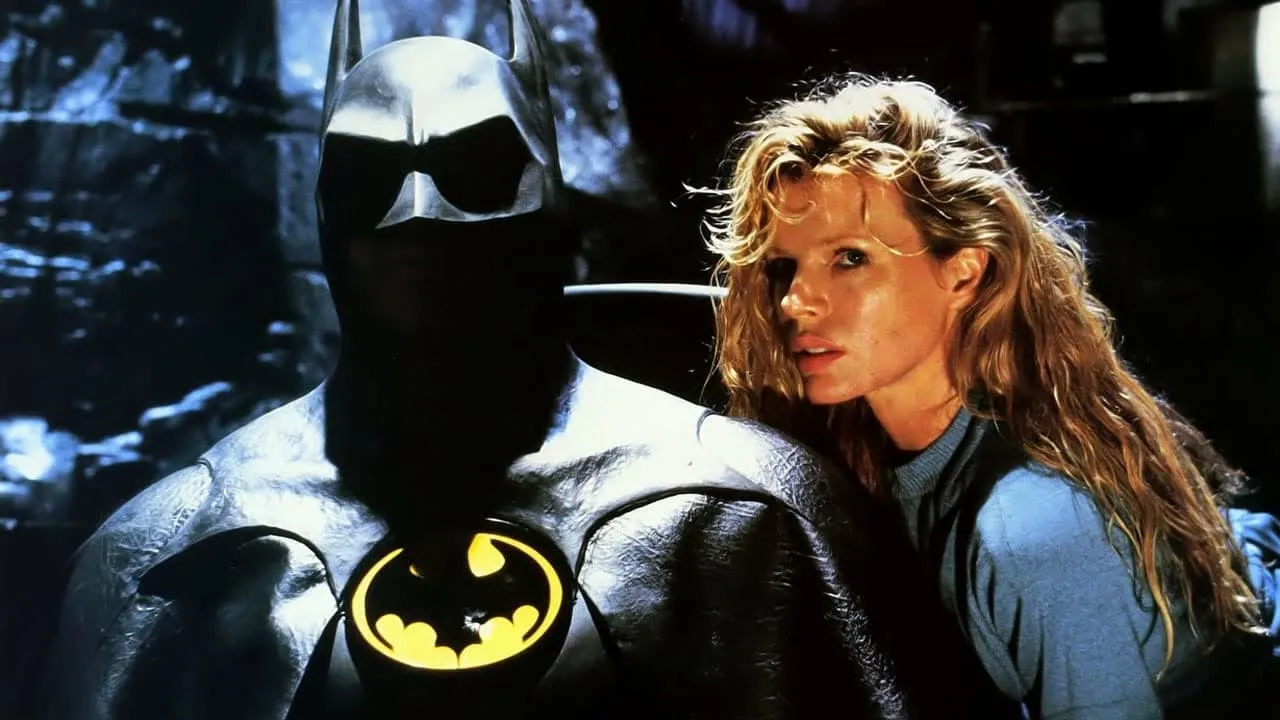
(SPECIAL NOTE: Capsule version of the review is available here.)
Some films don't age very well. That aging sometimes manifests itself in most unusual ways. One example for that is the case of Batman, 1989 action spectacle directed by Tim Burton. What used to be the embodiment of everything associated with successful Hollywood blockbuster fifteen years ago now looks like low budget art-film.
The plot is based on the series of comic books created by Bob Kane. It starts in Gotham City, huge American metropolis preparing for the 200th anniversary of its foundation. This is not very happy occasion because the town is infested with all kinds of crime, ranging from street muggers to powerful syndicate led by Carl Grissom (played by Jack Palance). City authorities, despite their best efforts, can't really cope with the situation, but everything changes with arrival of mysterious and deadly vigilante in bat costume. Reporter Alexander Knox (played by Robert Wuhl) decides to investigate "Batman" rumours with the help of attractive photographer Vicki Vale (played by Kim Basinger). During the investigation Vale falls in love with Bruce Wayne (played by Michael Keaton), wealthy local industrialist with traumatic past. After a while, another mysterious force appears in Gotham City. Jack Napier (played by Jack Nicholson), former lieutenant in Grissom's organisation, re-emerges after being terribly disfigured, starts calling himself The Joker and takes over city's criminal underworld. The Joker, whose unrestrained criminal insanity is matched by his scientific genius, sees Batman as the only man capable of stopping his diabolical plans and that leads to inevitable conflict on the streets of Gotham City.
Tim Burton's Batman is just one of the many incarnations of the character. Each of them was the product of its time and it is reflected in the atmosphere and issues. The original series of comic books was deeply influenced by Great Depression, rise of Fascism and explosion of crime dominating the newspaper headlines of 1930s America – it all reflected in Batman being one of the most serious and tragic comic book heroes. The 1960s television series, on the other hand, was product of post-WW2 optimism and it is best known for its campy, light-hearted approach to the character. 1980s brought another famous incarnation of Batman in Frank Miller's graphic novel; this revisionist version pitted old world-weary crime fighter against cynical, post-Watergate and post-Vietnam society. Burton in his version of Batman took some inspiration from Frank Miller, but the most visible influences came from 1940s. This is best seen in semi- futuristic vision of Gotham City as a combination of antique and modernity - Anton Furst's "Oscar"-awarded production design is reminiscent of 1930s architecture, combined with heavy Gothic influences; the costumes clearly belong to 1940s, but the cars, television set and other pieces of technology belong to 1980s, just like Prince's songs. All that adds to surreal but very consistent world that manages to amaze the audiences even today.
On the other hand, if Burton's idea was to mix modernity with 1940s nostalgia, there is very little modernity in Batman today. The film was almost completely made in Pinewood studios, and, unlike in most of today's film that try to emulate its style, viewers could notice the artificiality of its world. This is partly because of matte paintings and partly because of other special effects that clearly show how Batman was made before CGI technology. On the other hand, primitive level of special effects isn't too distracting, because action and fight scenes tend to be very short and effective - Burton paid more attention to creating atmosphere. Because of that Batman has the plot that moves relatively slowly compared with today's Hollywood blockbusters; the very slowness of the film, on the other hand, allows the audience to enjoy minor but often fascinating details of the film. Another element of the film's atmosphere is very effective music soundtrack by Danny Elfman.
Unfortunately, Burton's screenwriters Sam Hamm and Warren Skaaren weren't that successful with the plot and characters for Batman. The basic story of the origins of Batman is still here, but in obvious attempt to make this story a little bit darker (while not going as far as Frank Miller did) the screenwriters hint that hero has too much in common with the villain. They provide that villain in the form of The Joker. This provided opportunity for Nicholson for one of the most effective and most memorable performances of his career. Nicholson clearly has a lot of fun playing that over-the-top mobsterand steals the show with his unrestrained diabolical insanity. Michael Keaton, despite all of his efforts, simply can't match Nicholson and his portrayal of Wayne looks bland in comparison. On the other hand, Keaton's role in the film at least serves some purpose, but Kim Basinger's talent here is reduced to looking pretty and providing the film with obligatory (and not very credible) romantic subplot. Other actors are as overshadowed by Nicholson as Keaton is; only Michael Gough in small role of Wayne's faithful butler leaves something close to memorable impression.
Batman isn't as amazing today as it was fifteen years ago. But it nevertheless provides two hours of more than solid entertainment and, unlike most of blockbusters of today, shows that artistic sensibilities can coexist with commercial nature of Hollywood.
RATING: 7/10 (+++)
(Note: The text in its original form was posted in Usenet newsgroup rec.arts.films.reviews on May 20th 2004)
==
Blog in Croatian https://draxblog.com
Blog in English https://draxreview.wordpress.com/
Cent profile https://beta.cent.co/@drax
Minds profile https://www.minds.com/drax_rp_nc
Uptrennd profile https://www.uptrennd.com/user/MTYzNA
Brave browser: https://brave.com/dra011
BTC donations: 1EWxiMiP6iiG9rger3NuUSd6HByaxQWafG
ETH donations: 0xB305F144323b99e6f8b1d66f5D7DE78B498C32A7


